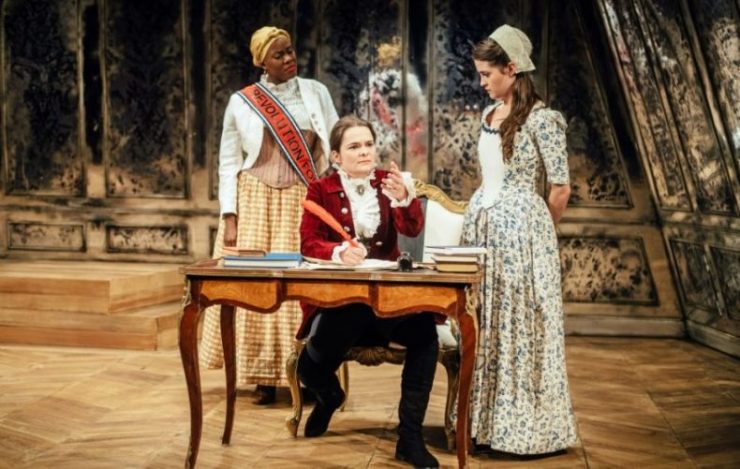
The Revolutionists by Lauren Gunderson; directed by Kathryn MacMillan at Theatre Horizon in Norristown, PA, February 2018.
This play, part of Theatre Horizon’s “Women Who Dare”“ season, presents women during the French Revolution who speak to us with modern language and sassy attitudes. It works best as a comedy with its flippant, irreverent gags, and not so well when it turns melodramatic.
The set by Brian Dudekiewicz is intentionally off-kilter, with trapezoidal walls and a tilted chandelier. We are in 1793, during the Reign of Terror — after the execution of King Louis XVI and before the emergence of Napoleon. It was the bloody time of Maximilien de Robespierre who executed thousands of opponents — or unlucky folks who were denounced by anonymous finger-pointers.
Theater-goers who recall the play Marat/Sade or the opera Andrea Chenier will appreciate this story. Other attendees will miss a lot, because playwright Lauren Gunderson skims the surface of history and omits much pertinent information. She also trades in stereotypes. The four female characters are cartoons, but their lines are funny. And it is clever — although disconcerting — to find laughs in a bloody fratricide which saw the execution of 17,000 people by their neighbors.
The first character we meet is Olympe de Gouges (a bold Charlotte Northeast), a real person who wrote “The Declaration of the Rights of Woman and the Female Citizen” in 1791. She’s trying to author a play but has writer’s block. In walks the fictional Marianne (a commanding Jaylene Clark Owens), a spy from Saint-Domingue in the Caribbean, which became Haiti, who only cares about the Revolution as a tool because her husband is back on the island trying to wrest its independence from France. To give an idea of this play’s humor, the spy wears a banner that says “Revolution” in big letters.
Next enters Charlotte Corday (a deadpan Claire Inie-Richards), who later will assassinate the radical writer Jean-Paul Marat and who wants Olympe to pen a quotable line that she can proclaim on the occasion. Finally we meet Marie Antoinette (a deliciously flighty Jessica Bedford) who wants to hire Olympe to do a rewrite of her life’s story. “I care,” she says, “I just need better press.”
Owens’s Marianne was potentially the most interesting character but the script gave her inadequate opportunity. I especially regret the chance to learn more about the people of Haiti and their struggle for independence. Few Americans know that Haiti, a free black republic, was only the second independent nation in the New World, in 1804, led by a man named Toussaint Louverture.
There are no men in the cast. That fact has made The Revolutionists a popular choice for theater companies in our era, abetted by the rising idea that women should have more control over their lives, and probably over all our lives as elected officials. Audiences in 2018 will certainly recognize powerful men silencing women, but this play doesn’t do anything specific to underline that point.
King Louis was tried and executed because he had ordered the French army to march against the citizens of Paris. He was guillotined in January of 1793. The excuse for the Reign of Terror was to defend France from a threat posed by the alliance of Austria, Prussia and Great Britain who “pledged themselves to re-erect in France the throne of the absolute monarchy.” King Leopold of Austria was the brother of Marie Antionette, and she lost her head nine months after her husband’s.
The Revolutionists will entertain almost everyone who supports the feminist movement, men as much as women. Additional points are scored with references to modern times, and to the theatrical profession. Yet it’s all surface humor, with no depth. Then, in Act Two, we see the women, separately, have their heads guillotined. Director Kathryn MacMillan portrays this dramatically with the vivid use of red ribbons. The switch from comedy to tragedy is clumsy, however, and feels unearned.
The colorful costumes are by Janus Stefanowicz and the strikingly dramatic lighting is by Lily Fossner.